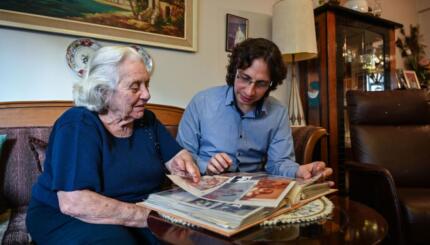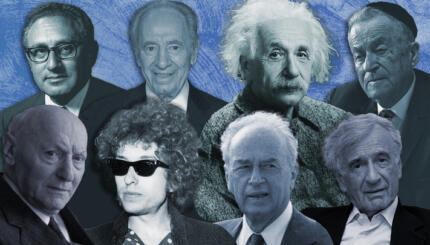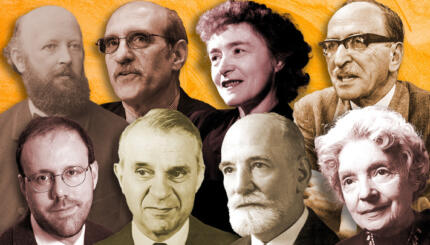Jules Olitski’s painting Dance of David from his series With Love and Disregard (2002) is aptly titled. The work consists of lush swirling forms of blue, white, black, yellow, and brown set on a red background, but the non-representative painting seems to disregard King David’s actual dance (from 2 Samuel, Chapter 6).
Indeed, many of Olitski’s titles tackled large narrative topics, often biblical–like his paintings Belshazzar’s Feast, Play of Daniel, Susy and the Elders, Rapture of Angels–but he never allowed himself to become a slave to those literal stories.
Instead, like a child finger painting or smearing icing on a cake, Olitski–who died on February 4, 2007–redefined painting as an act of mark making. He boldly abandoned the traditional mode of painting (an action done to a canvas with a brush) and used a spray gun to stain his canvases, in search of “a spray of color that hangs like a cloud, but does not lose its shape.”
Like few painters before him, Olitski attached himself to biblical themes and narratives. In 1959, he painted Bathsheba II, and his most recent body of work contains many references to the Bible. But one critic argues that the most Jewish aspect of Olitski the painter was his “stylistic joie de vivre” with a “characteristically Jewish” blend.
With your help, My Jewish Learning can provide endless opportunities for learning, connection and discovery.
The Young Dyer
If Olitski’s painting career was an effort in cloud making, he was born into a tragic storm. Jules Olitski was born Jevel Demikovsky in Snovsk (now Ukraine) on March 27, 1922, just months after the Bolsheviks executed his father. In 1923, he immigrated with his mother and grandmother to New York. His mother remarried, and young Jevel took his stepfather, Hyman Olitsky’s name in 1926 (the name was later misspelled on a document, which yielded “Olitski”).
Growing up in New York, Olitski sold papers at age 11 and was shocked that people ignored the news trickling out from Europe about the Holocaust. “I was living in this community of decent people, but most of them had never seen a Jew. My teachers thought I was Irish,” he told one reporter at age 68 at the dedication of his seven-paneled Star of David sculpture commissioned by the Beth Tzedec (Toronto) congregation’s Holocaust Memorial Committee.
“Why was nothing said or done about the Holocaust? This terrible silence has haunted me all my life.” Olitski called the sculpture Elyon (heavenly) to evoke “all the lights that God created.” He said the project represented the first time “I could speak through my art as a Jew” and told the reporter, “I hope my work is imbued with this light. As an artist, I feel for a work of art to be any good it must be alive. It must be a work that lifts the spirits.”
Olitski studied at the National Academy of Design and Beaux-Arts Institute in New York between 1939 and 1942. He served in World War II and subsequently traveled to Paris on the G.I. bill in 1949, studying with Ossip Zadkine in the Zadkine School of Sculpture (1949) and in the Academia de la Grande Chaumiere (1949-1950). He returned to New York in 1951, where he earned his bachelor’s (1952) and master’s (1954) in art education from New York University.
In 1956, Olitski began teaching at C. W. Post College of Long Island University, where he taught and served as chairman of the fine arts division until 1963. In 1963, he began teaching at Bennington College in Vermont, where he taught for four years. In between, Olitski met art critic Clement Greenberg, who helped launch him to stardom and would later call him “the best living painter.” Olitski eventually showed his work in more than 150 one-man exhibits, and he was only the third living artist to earn a one-man show at the Metropolitan Museum of Art in New York.
A New Kind of Paint Surface
Olitski did not always paint with the thick surfaces of With Love and Disregard. In the early 1960s, he began staining his canvases with dyes of thinned paints. But it was not until 1965 that Olitski used a spray gun, which he rented from a hardware store in Bennington. He credited the discovery to a dream, “lying in bed, imagining a painting.”
In a catalog essay for Olitski’s work at the 1966 Venice Biennale, Greenberg called Olitski’s “grainy,” sprayed surface “a new kind of paint surface,” which “offers tactile associations hitherto foreign, more or less, to picture-making; and it does new things with color.” Greenberg noted the sprayed paint became flat, yet managed “not to violate flatness.”
Flatness was a hobbyhorse of the second generation of American abstract artists, like Olitski, Morris Louis, Kenneth Noland, and Helen Frankenthaler. Where the Old Masters had banished the flat from their works and replaced it with illusive “tricks” that created depth, Greenberg and company embraced flatness, which they held as intrinsic and inextricable from the canvas.
Olitski’s Chinese Dinner Girl (1965) is a vertical canvas (just more than three times as tall as it is wide) with a misty temperament, composed of reds, blues, and purples. Although the paint in Chinese Dinner Girl fills the entire canvas, in other works from this period like #9 Green (1966) and Steamed (1968), Olitski painted opaque, thick lines in a corner of the painting, almost acting like a frame. At first glance, the brush strokes seem like errors, as if Olitski had forgotten to paint up to the edges of the canvas, but the strokes ultimately served to ground the cloudy colors and to introduce tension between the two elements.
Like Chagall’s kissing couples and Rothko’s rectangles, Olitski’s clouds appear to soar out of the picture, and yet they convey weight which grounds them. One writer referred to Olitski’s colors as seeming to “float in a spatial vacuum.”
Judging the Monoprints
Although his work diverges greatly from Picasso’s cubist works, Olitski’s evolution of styles and constant redefinition of his artistic vision recalls Picasso’s career, which is best described as fashion art. Perhaps like no other artist before him, Picasso kept his finger on the market’s pulse, and gave the buying public just what it wanted. Often, Picasso proved quite adept at predicting trends before they began.
Olitski certainly did not sell as well as Picasso, but following his staining and dying phase, he began creating thicker, textured works like Noble Regard (1989), which looks like a bronzed intestine cropped to look like a maze. The textured works gave way to Olitski’s final body of monotypes, mostly of landscapes depicted in soft pastel colors. A monotype is a painter’s print, or a print that yields a one-of-a-kind image. Olitski scraped into the paint with his fingers and other tools before printing them.
The 2004 monotypes include Amid Sailboats an Angel, a “sea” of orange, pink, yellow, and blue with triangular boats and a wading figure. A circular form which surrounds the boats could either represent a whirlpool that will swallow them up or an upward, spiral motion that could launch the boats into the clouds. Moon Ravished is framed by four pink strokes, with an orange ground and green sky containing a white moon.

Amid Sailboats an Angel
Courtesy of Lauren Poster Olitski.
Many of the monoprints are biblical. Jakim’s Dream probably references Jehoiachim, and After the Fire (an Elijah reference from 1 Kings), Dancing Hannah, and Reumah Waiting also derive from biblical tales.
Although the media overwhelmingly responded positively to the monoprints, some writers pointed to a sunken reputation and Olitski becoming “a victim of the rise of conceptual art.” The criticism hardly bothered Olitski, who often said, “Nobody asked me to be an artist.”

Moon Ravished
Courtesy of Lauren Poster Oliski
But many will remember Olitski as a Jewish artist, who quoted Isaac Bashevis Singer in artist’s statements, and wrote of his work in Genesis terms: “I ask the Almighty for help. That frees me. Look at what He is able to do with a handful of dust and a rib, and here I am with all this paint and a brush and my life in my hands, and all I need is to make a good work of art.” At an opening of Olitski’s work in Washington, D.C. in May 2006, his third wife, Kristina, added, “When my husband sells a painting, he gets down on his knees and thanks God.”
Perhaps it is no coincidence that Olitski’s model of a color spray that hangs like a cloud, but does not lose its shape so evokes the bush Moses encounters in Exodus, burning with flame but not consumed.


